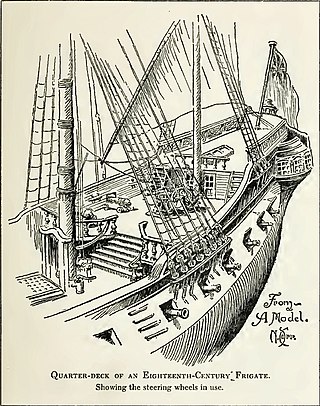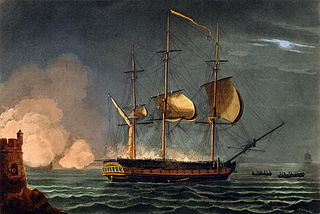
USS Constitution, also known as Old Ironsides, is a three-masted wooden-hulled heavy frigate of the United States Navy. She is the world's oldest commissioned naval warship still afloat. She was launched in 1797, one of six original frigates authorized for construction by the Naval Act of 1794 and the third constructed. The name "Constitution" was among ten names submitted to President George Washington by Secretary of War Timothy Pickering in March or May the frigates that were to be constructed. Joshua Humphreys designed the frigates to be the young Navy's capital ships, and so Constitution and her sister ships were larger and more heavily armed and built than standard frigates of the period. She was built at Edmund Hartt's shipyard in the North End of Boston, Massachusetts. Her first duties were to provide protection for American merchant shipping during the Quasi-War with France and to defeat the Barbary pirates in the First Barbary War.
Ship commissioning is the act or ceremony of placing a ship in active service and may be regarded as a particular application of the general concepts and practices of project commissioning. The term is most commonly applied to placing a warship in active duty with its country's military forces. The ceremonies involved are often rooted in centuries-old naval tradition.

A boatswain, bo's'n, bos'n, or bosun, also known as a deck boss, or a qualified member of the deck department, is the most senior rate of the deck department and is responsible for the components of a ship's hull. The boatswain supervises the other members of the ship's deck department, and typically is not a watchstander, except on vessels with small crews. Additional duties vary depending upon ship, crew, and circumstances.
This glossary of nautical terms is an alphabetical listing of terms and expressions connected with ships, shipping, seamanship and navigation on water. Some remain current, while many date from the 17th to 19th centuries. The word nautical derives from the Latin nauticus, from Greek nautikos, from nautēs: "sailor", from naus: "ship".

The quarterdeck is a raised deck behind the main mast of a sailing ship. Traditionally it was where the captain commanded his vessel and where the ship's colours were kept. This led to its use as the main ceremonial and reception area on board, and the word is still used to refer to such an area on a ship or even in naval establishments on land. Many such facilities have areas decorated like shipboard quarterdecks.

The Middle Ground Coastal Battery is a heritage site of an antique coastal artillery battery managed by the Indian Navy on an islet off the coast of Mumbai, India. It is situated on Middle Ground isle in Mumbai Harbour, a few hundred metres away from the Gateway of India, in Thane Creek.

HMS Hermione was the lead ship of the Hermione class, a six-ship class of 32-gun fifth-rate frigates of the Royal Navy. She was launched on 9 September 1782 at Bristol. Hermione was commissioned and then paid off a number of times during the 1780s. She underwent repairs between October 1790 and June 1792, followed by a period spent refitting at Chatham Dockyard until January 1793. She was recommissioned in December 1792 before sailing to the Jamaica in March 1793. Hermione served in the West Indies during the early years of the French Revolutionary Wars, participating in the British attack on Port-au-Prince, where she led a small squadron that accompanied troop transports.

Side boys are a naval tradition to welcome and send off dignitaries as they board and depart a Navy ship. Side boys are now also used for other ceremonial purposes on land such as during a change of command or retirement. They can be composed of either male or female members of the ship's crew, and act under the command of a Boatswain's mate, who gives commands with their pipe.

Georgios Averof is a modified Pisa-class armored cruiser built in Italy for the Royal Hellenic Navy in the first decade of the 20th century. The ship served as the Greek flagship during most of the first half of the century. Although popularly known as a battleship (θωρηκτό) in Greek, she is in fact an armored cruiser, the only ship of this type still in existence.
Seafaring is a tradition that encompasses a variety of professions and ranks. Each of these roles carries unique responsibilities that are integral to the successful operation of a seafaring vessel. A ship's crew can generally be divided into four main categories: the deck department, the engineering department, the steward's department, and other. The reasoning behind this is that a ship's bridge, filled with sophisticated navigational equipment, requires skills differing from those used on deck operations – such as berthing, cargo and/or military devices – which in turn requires skills different from those used in a ship's engine room and propulsion, and so on.
Boatswain is the seniormost rate of the deck department.

The capture of USS Chesapeake, also known as the Battle of Boston Harbor, was fought on 1 June 1813, between the Royal Navy frigate HMS Shannon and the United States Navy frigate USS Chesapeake, as part of the War of 1812 between the United States and the United Kingdom. The Chesapeake was captured in a brief but intense action in which 71 men were killed. This was the only frigate action of the war in which there was no preponderance of force on either side.

There are many customs and traditions associated with the Royal Navy of the United Kingdom. Many of these traditions have carried on to other Commonwealth navies, such as Canada, India, Australia and New Zealand. These include formal customs such as separate crests associated with ships, ensigns and fleet reviews. There are also several less formal customs and traditions, including Naval slang commonly referred to as Jack Speak and the traditional games of Uckers and Euchre.

The United States Navy occupational rating of boatswain's mate is a designation given by the Bureau of Naval Personnel (BUPERS) to enlisted members who were rated or "striking" for the rating as a deck seaman. The colloquial form of address for a boatswain's mate is "Boats".

The Battle of Iquique was a naval engagement on 21 May 1879, during the War of the Pacific, where a Chilean corvette commanded by Arturo Prat Chacón faced a Peruvian ironclad under Miguel Grau Seminario. The battle occurred off the port of Iquique, Peru, and ended with the sinking of the Chilean wooden corvette Esmeralda by the Peruvian ironclad Huáscar after four hours of combat, marking a victory for Peru.

A naval tradition is a tradition that is, or has been, observed in one or more navies.

Royal Navy ranks, rates, and uniforms of the 18th and 19th centuries were the original effort of the Royal Navy to create standardized rank and insignia system for use both at shore and at sea.

A bosun's chair is a device used to suspend a person from a rope to perform work aloft. Originally just a short plank or swath of heavy canvas, many modern bosun's chairs incorporate safety devices similar to those found in rock climbing harnesses such as safety clips and additional lines.

The Manhattan Rebellion was a failed coup attempt by officers of the Royal Thai Navy against the government of Prime Minister Plaek Phibunsongkhram (Phibun) on 29–30 June 1951. They took the prime minister hostage during a handover ceremony for the US dredge Manhattan and brought him aboard the Navy's flagship HTMS Sri Ayudhya. However, they were met by the combined forces of the Royal Thai Army, Air Force and Police. Heavy fighting ensued, and Sri Ayudhya was sunk despite Phibun's presence on board; the prime minister had to swim ashore along with the ship's crew. The event led to the Navy being stripped of most of its power and influence. It also showed that political power actually lay with commanders of the Armed Forces rather than the prime minister.
This glossary of nautical terms is an alphabetical listing of terms and expressions connected with ships, shipping, seamanship and navigation on water. Some remain current, while many date from the 17th to 19th centuries. The word nautical derives from the Latin nauticus, from Greek nautikos, from nautēs: "sailor", from naus: "ship".



















